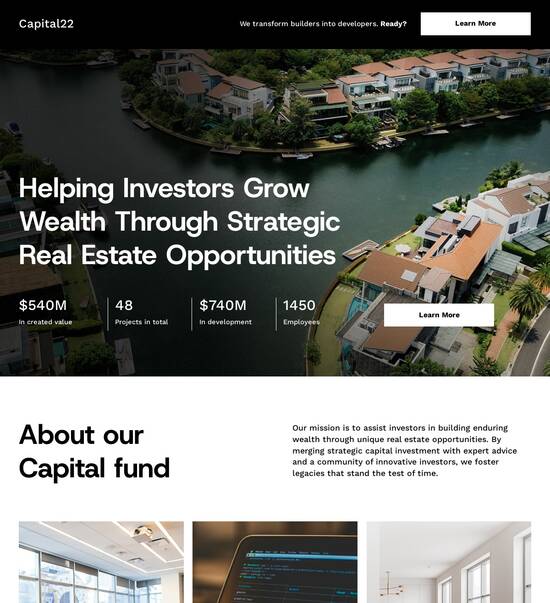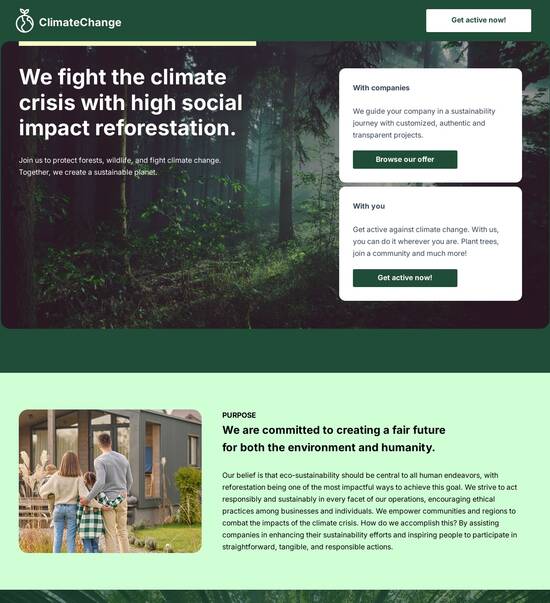
Versatile checkout page template
Explore Similar TemplatesAbout template
Unleash your creativity with the versatile checkout page template. Try Instapage today.
Recommended templates

Easy to build without coding
With the intuitive drag-and-drop builder, anyone on your team can create high-converting pages without any knowledge of code or design. Make enhancements to your landing page with custom widgets using Javascript, HTML/CSS, or third-party scripts.

Multiple layouts for any industry and goal
Select from 500+ landing page layouts built to boost conversions across industry-specific scenarios. Customize them by adjusting fonts, adding images, and generating on-brand content with the AI assistant. Quickly scale with Instablocks® and Global Blocks that you can save, reuse, and update globally.

Loads fast and looks polished on any device
Every template is responsive, which means they present professionally on any device and load blazingly fast with our Thor Render Engine. You can also power them up with Google AMP technology to deliver an unparalleled mobile experience and drive higher conversions.

Robust analytics & experimentation
Get real-time updates and reporting across all your devices, showing the number of visitors, conversions, cost-per-visitor, and cost-per-lead. Launch AI-powered experiments, run A/B tests, and use heatmaps to analyze user behavior, then optimize your landing page to maximize conversions.







Easy to build without coding
With the intuitive drag-and-drop builder, anyone on your team can create high-converting pages without any knowledge of code or design. Make enhancements to your landing page with custom widgets using Javascript, HTML/CSS, or third-party scripts.
Multiple layouts for any industry and goal
Select from 500+ landing page layouts built to boost conversions across industry-specific scenarios. Customize them by adjusting fonts, adding images, and generating on-brand content with the AI assistant. Quickly scale with Instablocks® and Global Blocks that you can save, reuse, and update globally.
Loads fast and looks polished on any device
Every template is responsive, which means they present professionally on any device and load blazingly fast with our Thor Render Engine.
Robust analytics & experimentation
Get real-time updates and reporting across all your devices, showing the number of visitors, conversions, cost-per-visitor, and cost-per-lead. Launch AI-powered experiments, run A/B tests, and use heatmaps to analyze user behavior, then optimize your landing page to maximize conversions.
All the features you need to build lead-generating landing pages
Explore more featuresLearn how to build top-performing landing pages for any goal
FAQs
Leading the way in building high-performing landing pages





A comprehensive guide to optimizing landing pages with Instapage
Creating powerful landing pages is essential for any marketer looking to enhance their digital campaigns. Instapage offers a versatile checkout page template that not only attracts visitors but also converts them into leads and customers, significantly boosting your ROI. In this guide, we’ll break down how to effectively utilize Instapage to transform your digital strategies, optimize your marketing efforts, and maximize results.
Understanding the importance of landing pages
Landing pages serve as your online storefronts, setting the tone for user interaction and driving conversions. They provide focused content tailored to your audience's needs, making them crucial for successful digital marketing. Using Instapage’s highly customizable templates ensures that your pages are not only visually appealing but also designed with conversion in mind. Key features include:
- High-converting designs: Instapage offers over 100 ready-to-use templates specifically designed to engage visitors and encourage action.
- User-friendly customization: No coding skills are required—instantly adjust layouts and text to match your branding.
- Built-in analytics: Track user behavior on your landing pages in real time, allowing for immediate adjustments based on performance.
Step 1: Choosing the right template
Selecting the perfect template is the first step to creating an effective landing page. Consider the following aspects when making your choice:
- Target Audience: Your template should resonate with your target audience's preferences and behaviors.
- Industry Relevance: Leverage templates that are tailored for your industry to increase relatability.
- Action-Oriented Design: Ensure that the template supports strong calls to action, making it easy for users to convert.
Step 2: Personalizing your landing page
Once you've chosen a template, personalizing it is vital to engage your audience effectively. Here are some strategies to consider:
- Dynamic text replacement: Use visitor data to customize messages that speak directly to individual users’ needs and expectations.
- Ad mapping: Align your ads with unique landing pages to ensure continuity in user experience—this can drastically reduce bounce rates and improve conversion.
- Audience metrics: Employ data tools to track how different segments of your audience interact with your content.
Step 3: Optimizing for conversions
After personalizing your landing page, the next step is optimization. Focus on the following:
- A/B testing: Regularly test different versions of your landing page to identify which elements resonate best with your audience.
- Heatmaps: Utilize heatmaps to visualize user interaction, allowing you to refine elements that may deter conversions.
- Performance analytics: Regularly analyze your page’s effectiveness to make targeted improvements.
Following these steps will help you leverage Instapage to craft high-performance landing pages that convert visitors into loyal customers.
Ready to elevate your marketing campaigns? Start using Instapage today and experience the transformative power of optimized landing pages.
People also ask about Versatile checkout page template
Understanding the versatility of the checkout page template: A comprehensive exploration
The essence of a checkout page
The checkout page plays a vital role in the customer's purchasing journey. It is often the last step before a customer completes their transaction, making it a critical touchpoint for retention and conversion. A well-designed checkout experience can significantly influence customer satisfaction and the likelihood of repeat purchases. The first impression a customer has when they arrive at the checkout page can make or break a sale.
To understand why the checkout page is crucial, consider that it essentially serves as a digital bridge between the customer and their desired product or service. If this bridge is shaky or poorly constructed, customers might choose to abandon their carts rather than navigate through an unsatisfactory experience.
Role in the customer journey
Importance of first impressions
The power of importing templates
Utilizing pre-built templates for checkout pages streamlines the design process and minimizes the time required to create an effective layout. Pre-built templates are designed with best practices in mind, ensuring that essential elements are incorporated, providing users with a cohesive and intuitive interface. This approach not only saves time but also allows businesses to focus on other critical aspects like marketing and customer engagement.
Additionally, these templates often come with customizable options, making it easier for businesses to personalize them to suit their brand identity. The ability to integrate various design formats—from single-page checkouts to multi-step processes—means that businesses can select what fits their needs best, increasing flexibility and adaptability.
Benefits of using pre-built templates
Hosting necessary customizations effortlessly
Adapting checkout pages for diverse needs
A versatile checkout page template allows customizations to fit various business models effectively. For instance, the requirements of an e-commerce platform may differ significantly from a service-based company. Recognizing these differences is crucial for designing checkout forms and processes that align with industry standards and meet specific customer needs.
In addition to customization for business types, understanding customer expectations can drive design decisions. Analyzing user behavior and iterating accordingly enables businesses to create a more seamless and pleasant user experience. This user-focused approach leads to higher conversion rates and fosters customer loyalty over time.
E-commerce vs. service-based checkout
Tailoring checkout forms by industry standards
Navigation through checkout methods and modules
Exploring different checkout methods is essential for meeting varied customer preferences. Single-step checkouts can be beneficial for customers looking for quick purchases, while multi-step checkouts may be more suitable for situations requiring detailed information. Providing options like one-click purchasing for returning customers represents a modern approach to enhancing convenience.
Furthermore, implementing modules can significantly improve the efficiency of the checkout process. Key modules for payment, shipping, and order summary can be prioritized to enhance functionality. By strategically placing these components, businesses can streamline the experience and minimize potential friction points, ultimately leading to lower cart abandonment.
Single-step vs. multi-step checkouts
One-click purchasing for recurring customers
Crafting checkout forms: The art of information gathering
The effectiveness of a checkout page hinges on its form design. Essential elements such as name, address, and payment details must be included to complete transactions efficiently. Striking a balance between gathering necessary information and keeping the user experience simple is a constant challenge. Overloading a checkout form with unnecessary fields can lead to frustration, encouraging users to abandon their carts.
Shortcodes can make the customization of checkout forms much easier and efficient. Utilizing shortcodes allows businesses to create custom forms that meet their unique needs without the necessity of complex coding. This capability facilitates rapid changes and adaptations, enabling marketers to respond to emerging trends or customer needs promptly.
Critical fields to include (name, address, payment)
Balancing detail with simplicity
A step-by-step guide to building your checkout page
Creating a successful checkout page begins with careful planning and consideration of the user journey. Initial brainstorming sessions should involve key stakeholders to gather insights and form a cohesive vision. Wireframing your ideal checkout experience can help visualize the flow and placement of various elements, allowing for adjustments before final design implementation.
After the wireframe is established, the next step involves implementation through flexible page builders. Various page builder tools are available, each offering its unique features and advantages. Comparison of these tools helps identify which best suits the specific needs and capabilities of the business. It’s fundamental to navigate potential challenges with customization, as learning new tools may require additional effort but ultimately pays off in enhanced functionality.
Initial planning and brainstorming sessions
Wireframing your ideal checkout experience
The funnel approach: Integrating checkout into the customer journey
Integrating the checkout page into the overall customer journey is foundational for optimizing the sales funnel. A well-structured funnel ensures that customers feel guided and supported from the moment they first encounter a landing page through to the final checkout. Consistency in design and messaging across all touchpoints enhances customer trust and fosters a smoother transition through various funnel stages.
Analyzing checkout performance within the funnel provides insights into key metrics necessary for improving conversion rates. Monitoring factors such as drop-off points and user behavior can help identify areas requiring refinement. Utilizing data-driven approaches to enhance the checkout experience is vital, as it demonstrates responsiveness to customer needs and preferences.
Importance of a well-structured funnel
Ensuring consistency from landing to checkout
Benefits of investing in versatile checkout page templates
Investing in versatile checkout page templates significantly enhances user experience, often leading to higher conversion rates. Psychological factors play a substantial role in influencing purchase decisions, making user interface design an essential consideration. Real-life success stories have demonstrated how optimized checkout experiences can result in substantial increases in conversion rates, underscoring the value of intentional design.
Furthermore, time and cost efficiency cannot be overstated when leveraging versatile templates. By simplifying the design process, businesses can save valuable resources on development time. These templates also allow for efficient updates, ensuring the checkout process can evolve alongside growing business needs and consumer expectations.
Psychological factors influencing purchase decisions
Cost savings on development time
Future trends for checkout page templates
As technology continuously advances, several innovations are anticipated for checkout page templates. Designs will likely evolve to prioritize mobile responsiveness and speed, as consumers increasingly use smartphones for their transactions. The future may also witness the integration of augmented reality elements to enhance the shopping experience, particularly in the realm of e-commerce.
The impact of AI and machine learning is also set to transform user interactions. Predictive analytics might enable more personalized experiences based on past behavior, thereby allowing businesses to adjust their offerings dynamically. Preparing for these evolving consumer behaviors is essential; adaptability in checkout design will ensure businesses remain competitive in a rapidly changing market.
Anticipated design trends for checkout pages
Impact of AI and machine learning on user interactions
The transformative impact of a versatile checkout experience
A versatile checkout experience can revolutionize the shopping process for users. Flexibility in design and functionality allows businesses to engage customers more meaningfully, increasing satisfaction levels. Personalized experiences can lead to higher retention rates, as customers appreciate tailored interactions that meet their specific needs.
Additionally, enhancing the checkout process helps close the gap between businesses and customers. By providing clear communication, efficient processes, and thoughtful designs, companies can foster trustworthy relationships with their customers. Ultimately, strong checkout experiences promote brand loyalty, paving the way for long-term success.
The role of flexibility in enhancing customer satisfaction
Building lasting relationships through improved checkout processes
Ready to skyrocket conversions?
Supercharge your ad campaigns with high-performing landing pages
Get started














